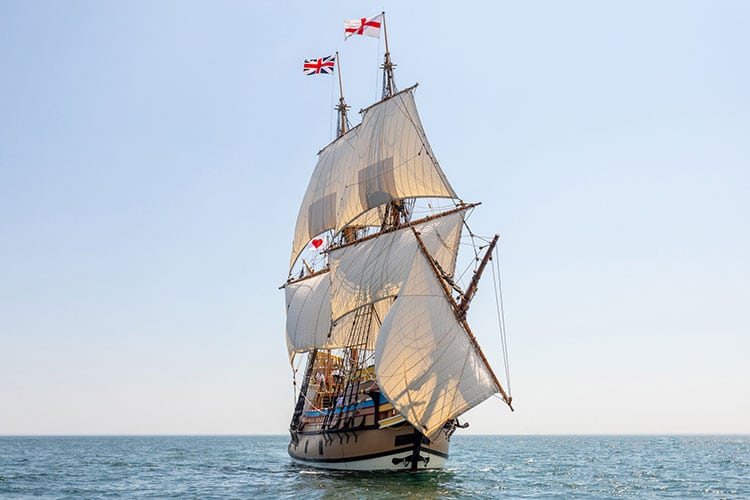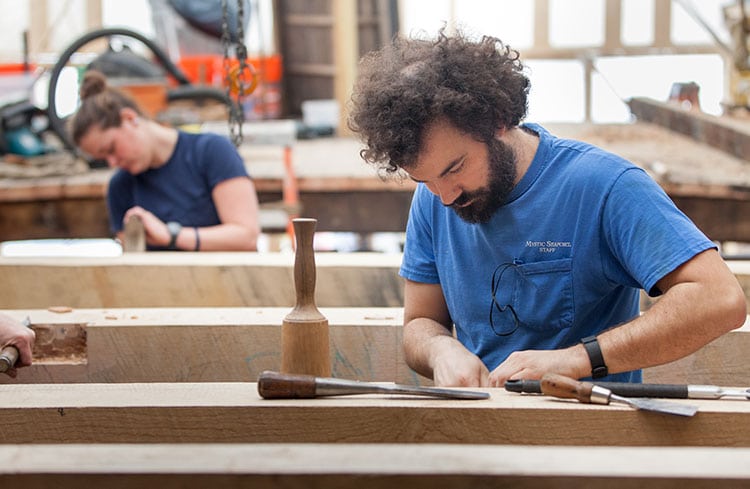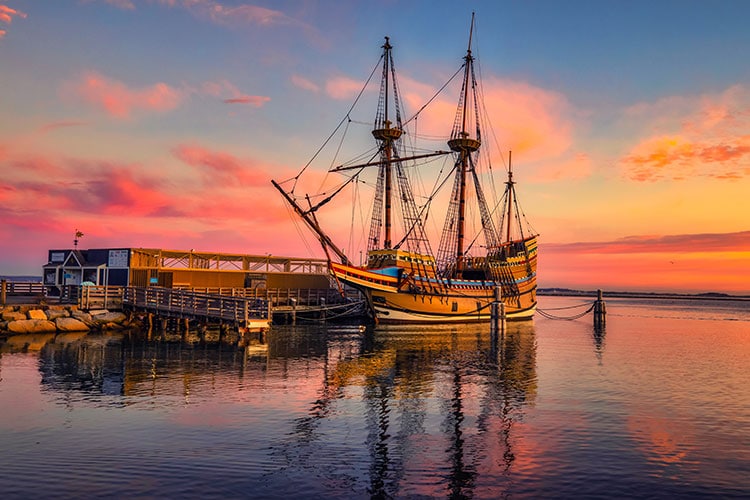
A Homecoming to Remember
Cape Cod Life / July 2021 / History
Writer: Brenna Collins
A Homecoming to Remember

Cape Cod Life / July 2021 / History
Writer: Brenna Collins
The intricate restoration of America’s most famous ship, the Mayflower II, and its journey back home to Plymouth.

On April 20, 1957, Mayflower II set sail from Plymouth, England to Plymouth, Massachusetts. The ship was gifted from the people of the United Kingdom to the people of the United States to serve as an emblem of the friendships developed between the American and British soldiers who served during World War II. As it docked on June 13, 1957 in Plymouth, 25,000 people awaited this historic moment, including then Vice President Richard Nixon and senator John F. Kennedy. Since then, 25 million people have stepped aboard to envision what those 102 passengers may have experienced in 1620.
Mayflower II was constructed in England using plans researched and created by renowned naval architect William A. Baker and commissioned by Plimoth Patuxet’s founder. Beginning in 2014, the 60-year-old reproduction vessel underwent a lengthy, meticulous restoration process using traditional materials and methods in a collaboration between Plimoth Patuxet and Mystic Seaport Museum.
In July 2020, the restored Mayflower II set sail to return from Mystic to Plymouth. A month later, spectators gathered, masked and socially distanced, as the ship made its way through the Cape Cod Canal, and finally, into Plymouth Harbor. One can’t help but notice the parallels between the two voyages in 1957 and 2020, both surrounded by global defining moments—the end of a world war, and 60 years later amidst a global pandemic.

“The return of the Mayflower II to Plymouth is significant on many levels,” said Lea Filson, President/CEO of See Plymouth. “First and foremost, seeing a replica of the ship allows a real-life experience today about one of America’s founding stories. For the town of Plymouth, its presence in the very place the Mayflower landed contributes immensely to tourism which is the #1 industry in the town and county of Plymouth.”
The initial discussions of a restoration began almost 10 years ago at Plimoth Patuxet, the offical steward of the vessel since its arrival in 1957. As with any wooden vessel, it was time for a major refit after more than half a century. In 2014, Whit Perry, Director of Maritime Preservation and Operations and Captain of the Mayflower II, was brought on to Plimoth’s staff to lead the restoration. A collaboration began with Mystic Seaport Museum, who had just completed the restoration of the Charles W. Morgan. “They have a great infrastructure for the care and maintenance of wooden vessels. We were very lucky to be able to work with them. Myself and two crew members lived in Mystic for three years, working right alongside the Mystic shipwrights,” Perry says. At Mystic Seaport Museum, Quentin Snediker, Director of the Henry B. duPont Preservation Shipyard, led the project in tandem with Perry.
In the winter of 2014, Mayflower II was brought in to Mystic for an initial inspection. “We did some testing to get an idea for the scope of the work that was envisioned for the major restoration. In the winter of 2016, she came for the full restoration for three years,” Snediker describes.

“The restoration was pretty deep, right down to the backbone of the ship. About 70% of the ship has been renewed. She still has some original timbers, but a lot was restored from deep inside the hull to the top of the mast,” Snediker continues.
Snediker, Perry and the rest of the crew closely adhered to the guidelines and procedures set in the preservation world for large wooden vessels. “Even though she’s a recreation from the 1950s, we recognize that the vessel has historic provenance in its own right. We approached it as if it were one of our national historic landmark vessels,” Snediker shares. His observation was confirmed as the ship was named to the National Register of Historic Places in September, 2020.
Materials were transported from across the globe to restore the ship with quality resources. For Whit Perry, the material acquisition was one of his favorite aspects of the process. “I began over seven years ago out in the woods with spray paint, actually marking trees that we would later use in the restoration. I was out in Connecticut, Massachusetts, Virginia and Louisiana. We worked with loggers to get the best wood. We actually took the wood from tree to sea, as I like to say. We had a collaboration with Berea College in Kentucky. They donated white oak trees, and I went down there and cut up the trees a mile into the woods with a portable saw mill. We were also very fortunate to purchase about 20,000 feet of white oak from Denmark that we used for under the waterline planking. It was over three inches thick and up to 40 feet long with no defects. That’s just not available domestically,” Perry says.

When it came to the actual labor, the team blended traditional techniques from the 17th century with modern instruments. The crew utilized electric powered saws and tools when necessary, but once on the ship, only the traditional tools could be used. “We used some tools that have been in use for a thousand years,” Snediker says. The final fit is very custom skilled work, and both institutions are passionate about spreading such traditional knowledge. “No matter what we can do with the modern tools, like taking the logs from tree to sea, from round to dimensional lumber, and no matter what we can use for machinery, once you get it up on the ship and in place, all of the intricate mortise and tenon joints have to be finished by hand as they were in 1957 and in the 17th century. It was very gratifying to pass along some of the skills down to younger folks,” Perry adds.
The Mystic Seaport Museum is dedicated to the visitor experience in the shipyard, where visitors can engage with craftspeople onsite while they explore the museum’s iconic historic waterfront village, collection of ships and historic houses. Throughout the Mayflower II’s restoration, as with all of their projects, curious onlookers were welcome.
After three years out of the water, Mayflower II was ready to set sail in the spring of 2020. Of course, the beginning of the pandemic brought complications, delaying the voyage and cancelling the larger plans that aligned with the 400th anniversary of the Mayflower’s arrival.

By the summer, the ship passed U. S. Coast Guard inspection and was ready to set sail under the leadership of Captain Whit Perry and 27 crew members. “The actual sailing of the vessel could not have gone off any better than I could have imagined. We sailed for over two weeks out of New London, Connecticut doing sea trials,” Perry says. Since the vessel has no propulsion engines, Charlie Mitchell, who has been towing Mayflower II for over 20 years, brought the ship back to the dock each night with the aid of the Tugboat JAGUAR. The crew closely followed COVID guidelines throughout the journey. Yet another curveball, incoming tropical storm Isaias forced the crew to add a stop in New Bedford for safety.
For its iconic passage through the Cape Cod Canal, thousands of spectators lined both banks. “People that had seen Mayflower II through the canal before, including me, had never seen so many spectators, even with COVID-19. It was amazing,” Perry says.
“We got back to Plymouth on August 10th, and the ship handled better than anything I ever could have imagined. We had sailed it more than it had been sailed all at once since 1957. The first feeling going through my head was relief that we got the ship back safe and sound. Second, bringing Mayflower II back after all that time and seeing the number of people on shore welcoming us amidst the pandemic was incredibly gratifying. It really put home how iconic this historic vessel is. For me, the first boat I ever restored was an Old Town canoe over 40 years ago, so to be able to be in the position of leading the restoration and being Captain of the Mayflower II was a feeling I couldn’t even describe. It was an honor bringing the ship back into its home port,” Perry reflects.

For Quentin Snediker, the collaboration between Plimoth Patuxet Museums and Mystic Seaport Museum was a fulfilling model between two nonprofits for one common goal. “When I look at a ship, I see it as a huge, collaborative sculpture because there’s not a piece of wood that’s straight or at a 90-degree angle. Everything is curved and angled to get to the beauty and form of a ship. The cooperation of so many craftspeople with the same vision and coming out with the finished product is really the greatest reward for me.”
At Plimoth Patuxet Museums, the Mayflower II is back in her home in her newly restored glory, where visitors can once again climb aboard and imagine the Mayflower’s voyage across the Atlantic 400 years ago. The ship is open daily to visitors from March through November. Thanks to the dedication of the Mystic Seaport Museum and Plimoth Patuxet Museums, she can remain a valuable resource for generations to come to remember our complex history.
Honoring its extensive restoration, in 2021, Mayflower II received the Paul & Niki Tsongas Preservation Award by Preservation Massachusetts, as well as their People’s Choice Award.
“Culturally and historically, Mayflower II means many different things to many different people. We know that keeping the history alive, and telling the complete story, is how we need to move forward. Mayflower II represents an important part in being able to tell that story,” Perry says.
Visit www.plimoth.org and www.mysticseaport.org to stay in the know about what is currently happening at both treasured museums.
Brenna Collins is the Story Editor for Cape Cod Life Publications.



